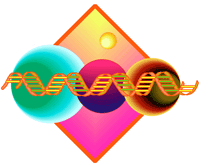
How Does Life Begin and Develop?
Goal
1
How
Life Arose on Earth
Goal
2
Organization of Matter into Living Systems
Goal
4
Coevolution of the Biosphere and the Earth
Does Life Exist Elsewhere in the Universe?
Goal
7
Signature of Life on Other Worlds
Goal
8
Life on Mars and Europa
What is Life's Future on Earth and Beyond?
Goal
9
Environmental Change on Earth
Goal
10
Terrestrial Life in Space
Question: Does Life Exist Elsewhere in the Universe?
Goal
8: Determine whether There Is (or Once Was) Life Elsewhere in Our Solar
System, Particularly on Mars and Europa
 Explore
the solar system from a biological perspective, emphasizing the search
for past or present life on Mars and Europa, the two places beyond Earth
that we know once supported liquid water.
Explore
the solar system from a biological perspective, emphasizing the search
for past or present life on Mars and Europa, the two places beyond Earth
that we know once supported liquid water.
Exciting data have presented us with the possibility that at least two
other worlds in our solar system have (or have had) liquid water present.
On Mars, there is evidence for stable flowing water early in that planet's
history. Both in situ investigations and the analysis of returned
samples will be necessary to understand Mars' historical climates and
its potential for life. Extensive exploration of the martian surface will
be required to evaluate the total potential for life on that planet, both
past and present. Furthermore, exploration of the subsurface probably
offers the only credible opportunity to find extant life on either Mars
or Europa. Other planetary missions may identify additional sites of biological
potential in our solar system.
Background
Beyond the Earth, the two worlds in our solar system that the are most likely to have, or have had, liquid water are Mars and Europa. The presence of liquid water, together with suitable energy sources, appears to be a requirement for life as we know it. On Mars there is evidence for stable flowing water early in that planet's history. Sedimentary deposits from possible paleolakes could hold fossil evidence of life that might have existed during this early wet period. Subsurface hydrothermal systems may persist on Mars today and are a possible target for a search for extant life. Both in situ investigations and the analysis of returned samples will be necessary to understand the past climate of Mars and its potential for life. In both cases, the selection of promising landing sites and identification of samples of biological significance are key. Europa is another planetary body, which probably has liquid water. If the presence of liquid water is confirmed, we will still need to address the history of these global oceans, to know whether they have persisted over geological time. Access to suitably selected europan surface samples may provide information on the contents of the water. On longer time-scales, deep penetration of the ice layer could provide a direct sample of the europan ocean and lead to remote submersible vehicles instrumented to search for evidence of marine life. Access to the deep subsurface of both Mars and Europa will required autonomous drilling technologies to provide the primary potential for discovery of extant alien life in our solar system. Understanding where to search and how to identify evidence for life are directly related to Goal 5, Goal 6, and Goal 7.